When to replant irises and how to do it correctly?
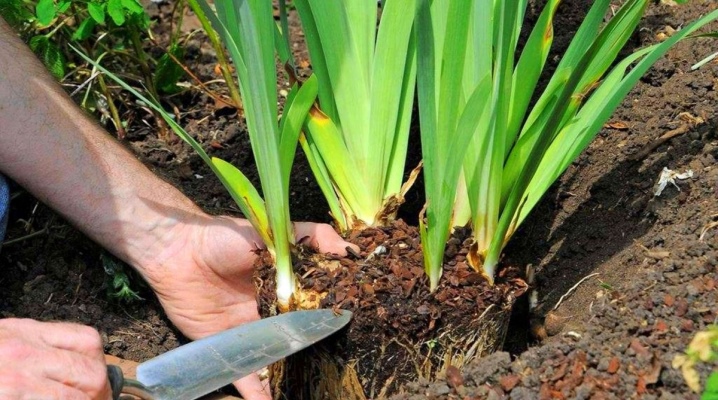
Iris is one of the few flowers that can be seen, probably, in almost every flower bed. Due to its incredible and unusual beauty, appearance and unsurpassed aroma, it has taken pride of place in many dachas. This article will focus specifically on irises, which are popularly called "cockerels", as well as how and when they need to be transplanted.
Peculiarities
Irises are striking representatives of the iris family. Thanks to the fruitful work of breeders, there are more than 750 species of this plant in the world today. It has erect leaves and large flowers. The range of colors is very diverse. Here are some important facts about this flower.
- Iris belongs to unpretentious plants that do not require special care. In order for the flower to feel well and grow, it is enough to water it regularly, loosen the soil, and remove weeds.
- Iris is not afraid of frost and even in cold weather feels great outdoors. But it shouldn't have a high level of acidity.
- This flower is thermophilic, it will grow poorly in a shaded area, and its flowering will not be bright and saturated enough.
- Iris loves water, but in moderation. A lot of moisture can cause disease.
- The plant needs feeding. You need to "pamper" him with fertilizers 3 times a year. The first fertilization should be done in the spring, when the iris is just beginning to sprout from the ground. In this case, you can use a mineral readily soluble fertilizer. It is necessary to feed the second time during the period when the bud begins to form. But the third fertilization occurs during the growing season of the plant.
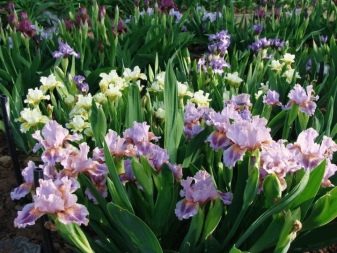

What is the transplant for?
Like any other plant, "cockerels" must be transplanted. Of course, beginners and inexperienced flower growers can often ask themselves why a transplant is needed, is it possible that a flower cannot grow in one place throughout the entire time. The need for transplanting is associated with the activity of the growth of the root system. Every year, the iris has a new root up to 12 centimeters long on it.
So, for several years, if you do not transplant, the root system will form a closed "lump", as a result of which it will not have enough space for further growth and air. All this will lead to the fact that the plant, due to its weakness, will often get sick and eventually die.
That is why it is very important to transplant irises, preferably every year. You just need to separate the new roots that are formed and plant them in another place.
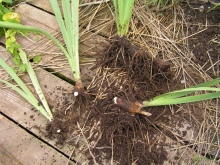
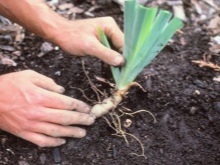
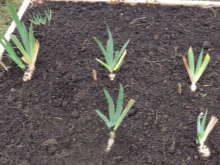
The right time
A very important and urgent issue is the timing of the transplant. We must choose the right time for this. Someone claims that iris is unpretentious, so it can be transplanted in any season. But experienced gardeners and summer residents, who have been growing "cockerels" for several years and watching their development, have a different opinion. They are confident that the ideal period for transplanting is spring, and it is better to do this at the end of May.
You can also transplant in the summer. The optimal month for this event is June. This manipulation can also be done in the fall, and it is better to transplant immediately after flowering.
It is strongly not recommended to transplant irises with buds that are in the process of flowering.Before transplanting, the buds must be cut off along with half of the leaves.
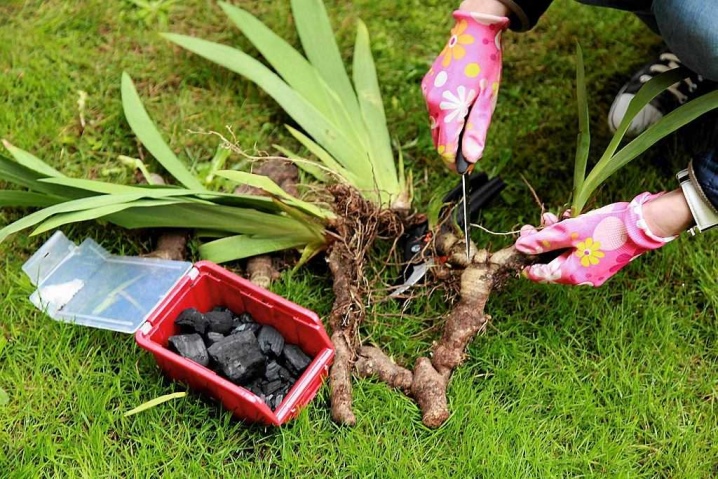
Seat selection
Of course, the chosen location is of great importance for the correct growth and beautiful flowering of irises. When deciding on him, you need to take into account the type of plant, because one of them may love a light and dry place, while the other, on the contrary, prefers to be in the shade. When replanting "cockerels" in open ground from one place to another, you need to consider:
- ground water level;
- acidity of the soil;
- saturation of the soil with oxygen;
- the amount of sunlight that will hit the plant.
Once the location has been determined, it needs to be prepared for planting irises about 3 weeks before the process. The soil must be dug up, all weeds and pests are removed. The soil should be fertilized, you can use peat and sand.
If necessary, lime will help to reduce the acidity level, it needs a very small amount, wood ash and dolomite flour.
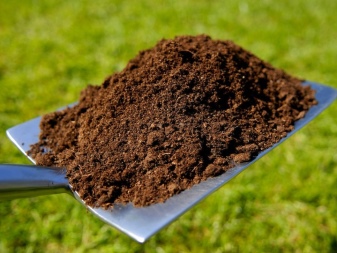
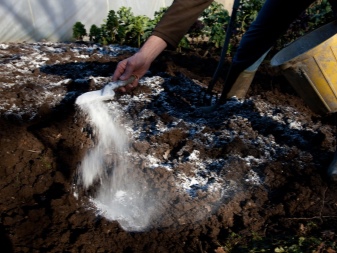
It is advisable to add fertilizers to the soil before transplanting. The soil for irises can be fertilized:
- "Kristalon";
- "Ammophos";
- "Aquamarine";
- Azofoskom;
- "Kemir";
- "Sudarushka".
These mineral supplements contain a sufficient amount of phosphorus, potassium, magnesium, manganese, iron, copper. If you follow these guidelines for choosing a landing site, you can be confident that it will be done correctly.

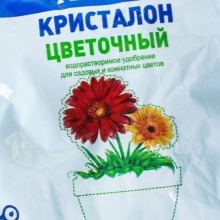
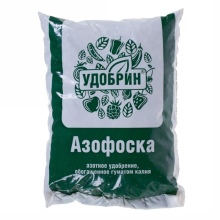
How to transplant?
So, it's time to decide on the basic rules and talk about how to properly dig, divide, prepare for transplantation and plant irises. Choose a place to transfer. Earlier we talked about how to correctly determine the future habitat of the plant. Prepare the site and add all the necessary mineral additives and substances to the soil. Next, you need to prepare the plant itself for transplantation. The process of preparing a "cock" consists of several stages.
- The first step is to completely dig out the plant that will be transplanted. This can be done with a shovel or pitchfork. Dig it out carefully so as not to damage the tubers.
- The dug out bush must be divided into approximately equal parts. The division of rhizomes is necessary so that each of the parts has its own already formed rosette with roots.
- Each individual link should be well rinsed and the root system inspected so that it is safe and sound. If a damaged or large part of the root is found, it must be removed - cut off with a knife.
- Next, you should tackle the leaves. They are cut at an angle in such a way that the visually executed cut resembles a fan.
- After that, you need to disinfect. To do this, prepare a manganese solution with the addition of a specially formulated drug called "Maxim". You can buy it at any specialty store.
- A flower already prepared for planting can be placed in open ground in a new place.

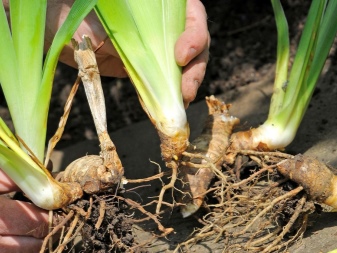
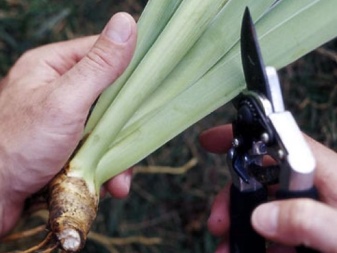
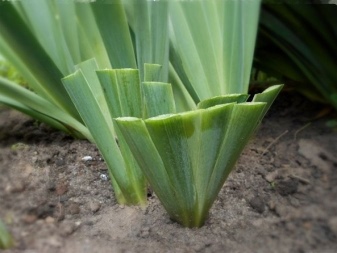
After all the manipulations done, you need to prepare the holes, the distance between which should be at least 45 centimeters from each other. This distance is necessary so that the root system can develop and grow without obstacles. You can plant the resulting part of the plant in the finished holes, but you don't need to deeply bury the tubers into the ground. Water each well after planting. As you can see, the planting process is quite simple and does not take much time.
The day you plan to transplant should be dry, warm and not rainy. A rainy day is not suitable due to the fact that moisture can accumulate near the holes and negatively affect the process of plant adaptation in a new place.
The choice of neighbors for iris also needs to be approached very responsibly. "Petushki" can be planted near onions, peonies and poppies, magnolia and birch, phlox, lavender, willow and clematis.

Further care
After the plant is transplanted, it is necessary to properly care for it. Follow these guidelines:
- irises transplanted in autumn need to be watered rarely, only if there has been no rain for a long time;
- in the cold season, it is not necessary to fertilize the soil in the habitat of irises; there is also no need for mineral supplements in winter;
- iris is a frost-resistant plant that is not at all afraid of a sharp temperature drop, therefore it does not need insulation;
- after hibernation, when the warm season comes, the "cockerels" need to be fed until they bloom, and during the flowering period they need frequent watering.
Do not forget to carefully inspect the plant visually to make sure that it has not been attacked by various pests and has not gotten sick. Irises are most susceptible to such diseases:
- rhizoctonia;
- fusarium;
- fusarium rot;
- botrytis;
- heterosporiasis;
- leaf spot;
- rust.



As for pests, most often the "cockerels" are attacked by:
- aphid;
- scoop;
- thrips;
- bear;
- wireworm;
- kivsyak;
- beetle, beetle;
- slime.
To combat each of the above pests and diseases, there are methods and drugs for prevention and treatment. As soon as you notice that another hostile life has appeared on the plant, you should not waste a minute to run to a special store and buy the necessary drug.
If you process the plant in time, most likely it will continue to grow and delight further.
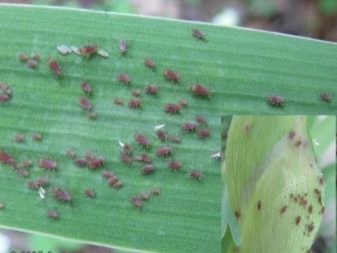
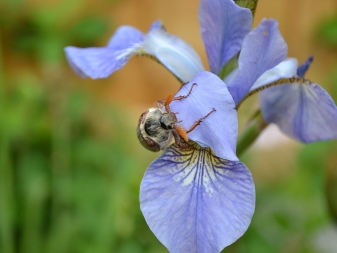
How to properly transplant irises, see below.







































































































The comment was sent successfully.